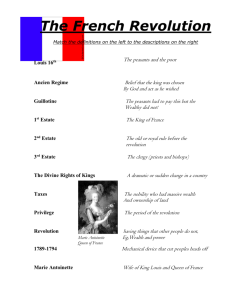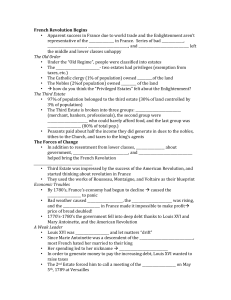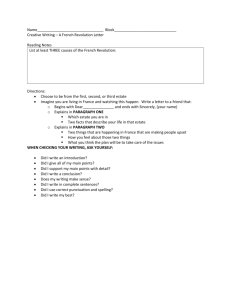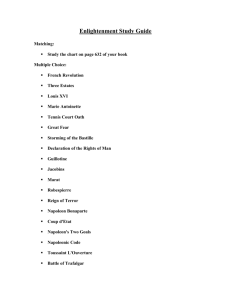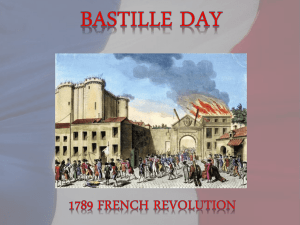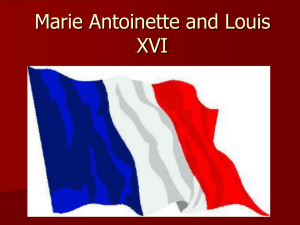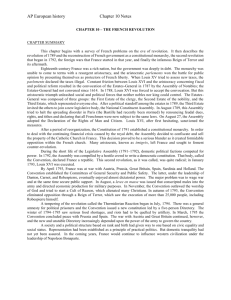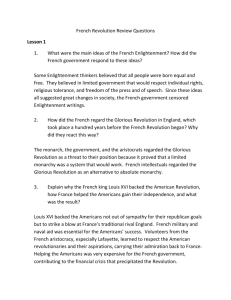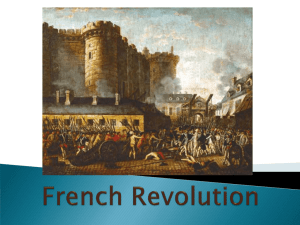French Revolution
advertisement
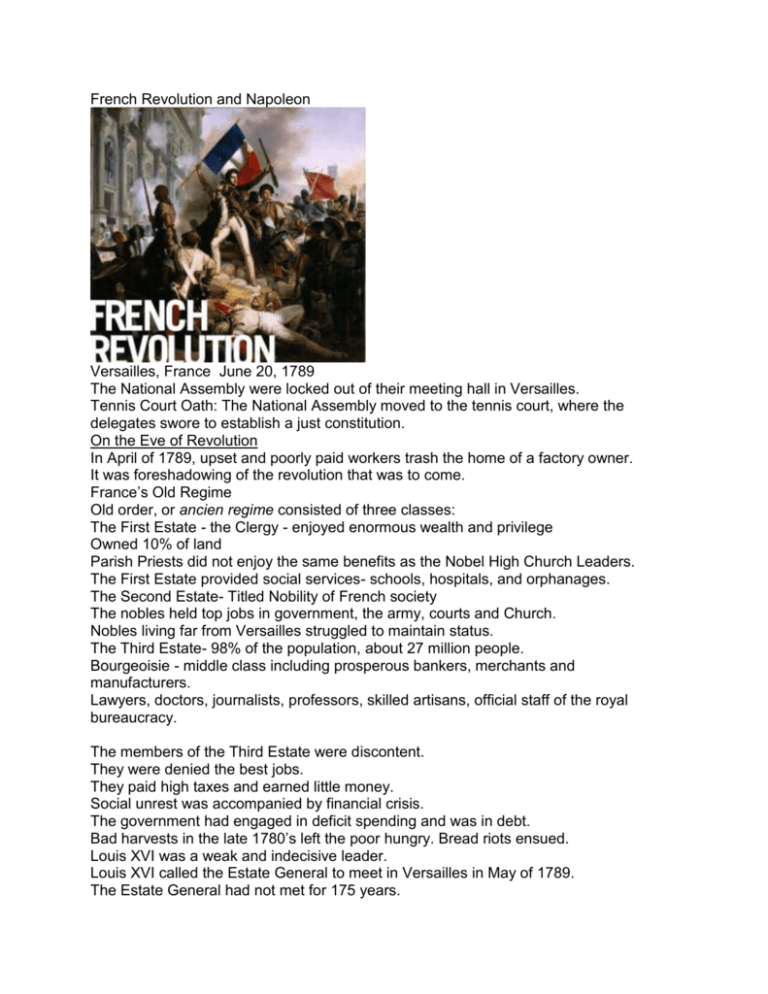
French Revolution and Napoleon Versailles, France June 20, 1789 The National Assembly were locked out of their meeting hall in Versailles. Tennis Court Oath: The National Assembly moved to the tennis court, where the delegates swore to establish a just constitution. On the Eve of Revolution In April of 1789, upset and poorly paid workers trash the home of a factory owner. It was foreshadowing of the revolution that was to come. France’s Old Regime Old order, or ancien regime consisted of three classes: The First Estate - the Clergy - enjoyed enormous wealth and privilege Owned 10% of land Parish Priests did not enjoy the same benefits as the Nobel High Church Leaders. The First Estate provided social services- schools, hospitals, and orphanages. The Second Estate- Titled Nobility of French society The nobles held top jobs in government, the army, courts and Church. Nobles living far from Versailles struggled to maintain status. The Third Estate- 98% of the population, about 27 million people. Bourgeoisie - middle class including prosperous bankers, merchants and manufacturers. Lawyers, doctors, journalists, professors, skilled artisans, official staff of the royal bureaucracy. The members of the Third Estate were discontent. They were denied the best jobs. They paid high taxes and earned little money. Social unrest was accompanied by financial crisis. The government had engaged in deficit spending and was in debt. Bad harvests in the late 1780’s left the poor hungry. Bread riots ensued. Louis XVI was a weak and indecisive leader. Louis XVI called the Estate General to meet in Versailles in May of 1789. The Estate General had not met for 175 years. The members from the Third Estate were familiar with the writings of Voltaire, Rousseau and other philosophes. The Third Estate established themselves as the National Assembly and asked the members the other estates to join them in drafting a constitution. Storming the Bastille. July 14. The Bastille was a prison in Paris. A crowd of 800 gathered to demand weapons from the fortress. Parisians thought that royal troops were coming to occupy the capital. The guards fired on the mob, and a battle ensued. Creating a new France Four phasesModerate - Era of the National Assembly creating Constitutional monarchy Radical phase of escalating violence leading to the Reign of Terror. Directory- period of reaction against extremism Age of Napoleon The Great Fear - people behave badly in desperate times. Paris in turmoil - People look to the Marquis de Lafayette who fought along with George Washington in the American Revolution. Liberty, Equality, Fraternity The nobles in the National Assembly voted to end their special privilege The Assembly issued the Declaration of the Rights of Man and the Citizen, modeled after the American Declaration of Independence. It insisted that governments exist to protect the natural rights of citizens, reflecting the ideas of John Locke and the philosophes. Louis XVI slow to accept reform. Nobles partied while peasants starved. October 5, thousands of desperate women marched 12 miles in a rainstorm to see the king. They wanted Louis XVI to know their suffering They demanded bread. They resented the queen, Marie Antoinette, for her frivolity. King Louis XVI and Marie Antoinette returned to Paris as virtual prisoners. The National Assembly followed the king to Paris. They voted to sell Church lands to pay government debts. The Clergy rejected the changes. The National Assembly produced a constitution that reflected Enlightenment goals Marie Antoinette was convinced Louis to escape Paris. They royal couple was discovered, accused of being traitors to the revolution, and beheaded by guillotine. They set up a limited monarchy. Legislative Assembly had power to make laws, collect taxes, and decide on war. Reaction Outside of France Enlightenment supporters were joyous. European rulers were fearful. The Legislative Assembly was unable to lessen food shortages. The sans-culottes, or working class, demanded a republic. Jacobins were a revolutionary political club who wanted to abolish the monarchy. The Legislative Assembly sat according to their political positions, left, middle, and right. The Assembly’s war on words exploded into war with Austria and Prussia. Radical Days 1793 The Revolution entered a radical phase. Bloody and violent events occurred as the Prussian forces cut down French recruits. Radicals took control of the Assembly and declared France a republic. The Jacobins erased as much of the old order as possible. King Louis was reduced to a citizen, tried as a traitor, and beheaded in Jan. 1793. His Queen suffered the same fate in Oct of 1793. Louis XVII died in the dungeons. The Convention Under Siege. France was threatened by war, rebellions, food shortages, and a divided Convention. Maximilien Robespierre lead the Committee of Public Safety. He was the chief architect of the Reign of Terror. 40,000 people died in prison or were executed from July 1793 to July 1794. The guillotine was considered more human than death by executioner’s ax. Women in the Revolution Jeanne Roland supported the Revolution through her writings, salons, and influence on her government minister husband. Olympe de Gouges demanded equal rights in her Declaration of the Rights of Women. Both women were victims of the Terror and met their end with the guillotine. Changes in Daily life Elaborate fashions were out, practical clothing was in. Nationalism spread throughout France. Social reforms included compulsory elementary education, government systems for the poor and for veterans. Slavery was abolished and in West Indian colonies and religious toleration extended. The Revolution was depicted by artist Jacques Louis David. Your assignment is to artistically depict the French RevolutionYou may make a model of a guillotine. You may... Make a model of the Bastille Create an invitation to a grand ball at King Louis XVI’s palace at Versailles Dress a doll in Marie Antoinette style. Draw a cartoon depicting the Three Estates. Write a letter to your mother explaining how you came to be detained in the dungeons of France during the Reign of Terror. Record a new National Anthem to France. Draw a map of Napoleon’s battle conquests. Create a poster promoting Napoleon for Emperor- include reasons why he should be considered. Write a Declaration of the Rights of Students . The royal family was moved to the Tuileries Palace. Not too shabby for political prisoners. Tinted etching of , 1792. The caption refers to Louis's capitulation to the National Assembly, and concludes "The same Louis XVI who bravely waits until his fellow citizens return to their hearths to plan a secret war and exact his revenge." Louis XVI of France sans coulette
